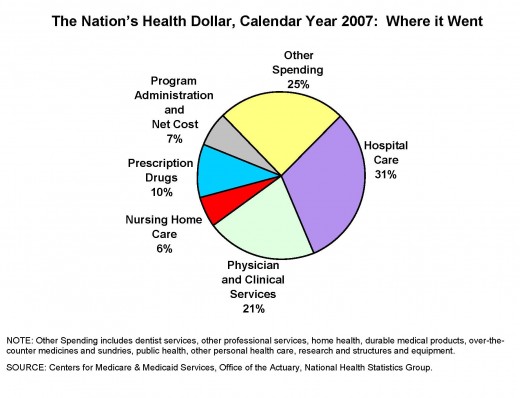Thinking Outside of the Healthcare Box
The Status Quo is Broken
The White House and Congressional leadership have done a terrible job of developing and promoting their Universal Healthcare program; thank goodness! While a vast majority of Americans accept that we need healthcare reform, the President’s rush to develop a national healthcare plan has so far resulted in a poorly thought out program that would accomplish few if any of the necessary reforms sought by the American people, and creates more costly government bureaucracy in the process. It’s time now for our government leaders to take a step back and focus anew on meeting actual healthcare needs, controlling costs, and simplifying programs in order to enhance the delivery of basic healthcare services to all Americans.
Healthcare expenditures in the US exceeded 2.4 trillion dollars last year, more than $7,800 per person, nearly twice as much per citizen than any other developed nation in the world, and more than 17% of our entire Gross National Product, also nearly twice as much as any other developed nation. Anyone can see that this is not only excessively costly but also unsustainable, especially given the current rate of cost increases for healthcare in the US. And who paid these healthcare costs? Not the insurance companies, not the government, and not even your employer if you’re lucky enough to have employer paid health insurance. You paid for it, we paid for it, the American people paid for it. Either directly or indirectly it came out of our earnings, either as direct payments, taxes, insurance premiums, or as lower net wages.
We should recognize also that the costs of providing healthcare to the so called under or un-insured are included in that huge national expenditure, and we the people are already paying those costs. Believe it or not, few people in this country are denied medical care when sickness threatens their life, and that is part of the problem, because instead of receiving regular healthcare that might help prevent sickness, the under and un-insured are forced to wait until they require the most costly care before seeking any care at all. And who pays for that? You guessed it, not the government, not the hospitals, not the doctors. You and I pay for it, in the form of taxes or higher hospital and doctor fees.

Is Insurance Viable?
There is one other aspect of our current healthcare system that many people don’t recognize (and the government certainly is not discussing due to the special interests involved), and that is the validity of health insurance itself. For something to be “insurable” two elements are required: first there must be a risk of something happening, but also a lack of certainty that it will happen; and second, that risk must be controllable, or at least the exposure to risk must be. The concept of insurance is not valid as it applies to paying for most healthcare services because “basic” healthcare is something that every person, man, woman, child, old and young requires, or will require, on a regular basis to maintain basic wellness. There is no risk that this care will be needed; it is certain that at least some level of care will be required by everyone. The only way that insurance companies can control their exposure to that certainty is by excluding people who pose the greatest risk of high costs; thus pre-existing conditions are excluded.
This is not to say that there is not a place at all for health insurance; there is, but it exists only at the upper levels of care, those levels of healthcare that are not universal, that we are at risk of, but not certain of, and the costs of funding the basic levels of care, the certain levels of care, could be reduced by eliminating the costs of “insurance” and going directly to healthcare providers in much the same way as our current Medicare and Federal Employees Benefit System does. Rather than excluding certain at-risk populations, we may in fact discover that the most effective way of controlling the risk and costs of “sick” care is by promoting access to regular basic “health” care for everyone.
As I stated in the beginning, the government needs to re-focus their approach, and Mr. Obama needs to encourage the change he so successfully touted before his election and start thinking outside of the current healthcare box. Our leaders need to stop lying to us and making unrealistic promises. We need to accept as a nation that the world is not perfect and we cannot afford to provide everything to everyone, because we don’t have the money and we can’t continue to borrow it from the Chinese, because some day we will have to pay it back, and we don’t have the money. Reality bites!
Our government leaders should restart his process by first developing some agreement and definition for a “basic” level of healthcare that this country can afford to provide to every man, woman, child, old and young; keep it simple, focused on “health” care, preventative services, and some limited (sorry, we can’t afford unlimited) “sick” care. Take out the controversial issues, the elective care, and focus on what we can agree on; there is surely enough of that.
Start with the Congressional healthcare plan, the federal employee plan, and Medicare / Medicaid benefits, and work backwards from there. Then let’s cover everyone (citizens & legal residents only) under a new National Basic Healthcare Program, and let the insurance companies continue to provide “insurance” where it applies, for those people who want and can afford expanded coverage.

Keep it Simple - Please
We will need to set a limit on annual expenditures, but since we are the richest country in the world let’s make that limit the most of any country in the world, say $5,000 per person, a total of 1.535 trillion dollars (64% of current expenditures), based on a population of 307 million. Of course this would have to be paid for with some form of tax (or premium ala Medicare), but let’s look at that again also.
If we eliminate, or reform, the current Medicare and Medicaid programs and the federal, state and other public employee insurance programs by integrating that coverage into the new Program, we would have approximately 1.1 trillion dollars in current tax based funding that could be applied to the new Program. Private insurance payments currently pay for 35% ($840 Billion) of all medical costs in the US; if 50% of those dollars were redirected to pay for the new Program (since there would be no need to cover “basic” healthcare costs under those insurance plans) that would provide an additional 420 billion dollars, resulting in total funding of 1.520 trillion dollars, leaving the Program with a relatively small 15 billion dollar (1%) shortfall that could realistically be made up by cost and operating efficiencies.
To keep it simple we will probably have to accept a single-payer system (I know – I’m not in favor of BIG government either), and some general tax or premium will have to be assessed, to be paid by everyone and thus include everyone, to fund this (or a reallocation of current premiums and taxes as mentioned above). That doesn’t mean a single provider system however, and I certainly don’t favor any so called “government option”. Medicare, Medicaid and the public employee systems are all single-payer systems now, but numerous healthcare providers compete to provide services and participate in these programs, and a similar approach could be utilized in the new Program to foster competition. Independent Regional Medical Boards (something along the lines of the Federal Reserve Board) could be established to set maximum rates and recommend changes to coverage, and the creation of non-subsidized, non-profit healthcare co-ops may also promote competition and cost controls. Minimizing the bureaucracy and administrative costs at all levels of the Program, while also aggressively pursuing fraud, should be major concerns of any program and would serve to further reduce and control costs.
Then, to smooth the transition, the program could be phased in over a five year period of time as the President has suggested. I would suggest that we start with all of the federal employees, including our legislators, and judges, and of course the un-insured, whom they are fighting so hard for, then all of the state and other public employees, who are all getting their health care courtesy of tax payers anyway, then Medicare and Medicaid participants, and finally all the private, and employer paid and union employee plan participants. In the end we would have a national healthcare plan with universal participation, instead of a so-called universal plan with only partial participation, and we might actually find a way to make it work with all of the stakeholders involved.
I’m sorry if this all seems too simple, but that’s the issue, everyone is still focusing on the very complicated status quo, and trying to add to it rather than reform it. Even though we all agree that the status quo is broken no one wants to give up anything they have, and everyone wants what the other guy has. We need to get out of that box and accept that when it comes to basic healthcare needs we are all equal (yes, Mr. Congressman, and Ms. Federal employee, that includes you) or nothing will change. If we can’t accept that basic premise then let’s give it up, or we are just going to get stuck with another costly additional federal program funded by you know who – me and you. Change is not easy, but keep it simple and it might just be easier than we think and better for everyone.







